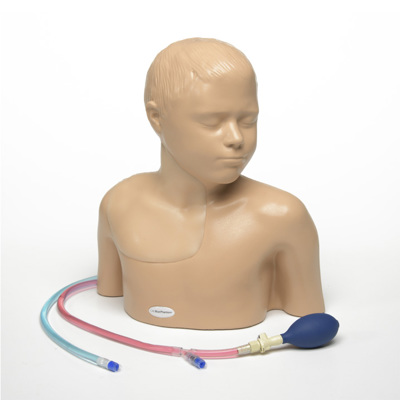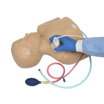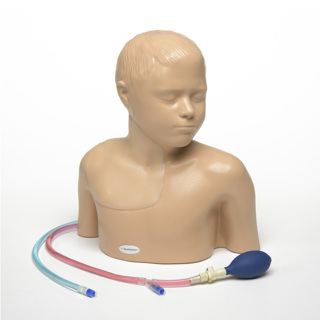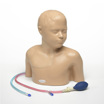ABP770 PAEDIATRIC REGIONAL ANAESTHESIA AND CENTRAL LINE ULTRASOUND TRAINING MODEL
For pricing information, please contact your local Distributor.
Skills
- Blue Phantom’s Paediatric Ultrasound Central Line and Regional Anaesthesia Training Model a realistic central line and nerve block simulator. The model provides realistic external landmarks while the internal anatomy is based on digital human files of a 6-year-old child.
- This ultra-durable manikin incorporates all the anatomy required to gain proficiency in using ultrasound for paediatric central line placement and peripheral nerve blocks. This model is excellent for both ultrasound-guided and blind insertion central line procedural training.
- The Paediatric Regional Anaesthesia Central Line Model offers anatomically correct brachial plexus and vascular access anatomy of the upper thorax and neck. This next-generation ultrasound mannequin contains improved anatomy for nerve blocks including the supraclavicular nerves, interscalene nerves, infraclavicular nerves and enhanced access of the posterior interscalene nerve block approach.
- The ultra-durable self-healing tissue withstands tremendous use, minimizing the need for replacement parts allowing clinicians to teach, practice and learn central line and regional anaesthesia procedures repeatedly and perform complete central line placements of the internal jugular and subclavian vein - including needles, guidewires, dilation, and threading of catheters.
- This model is excellent in utilising traditional external landmarks for blind insertion central line placement or using ultrasound to guide the central venous access procedure. The brachial plexus can be injected with simulated anaesthetics to verify needle tip location and to practice the entire anaesthesia procedure. Injected simulated anaesthetics are expelled allowing for repeated use.
- Arterial pulsation can be simulated via the manual hand bulb to differentiate between arteries and veins via ultrasound.
- Vessel identification is made easy by the immediate positive fluid flow of the vein versus artery. The venous system is prefilled with blue fluid and the arterial system is prefilled with red fluid.
- Users can positively identify the targeted vessels and receive immediate feedback as to successful or unsuccessful vascular access.
Features
- Blue Phantom’s simulated tissue, SimulexUS™, matches the acoustic properties of human tissue, providing clinicians with an extremely realistic training scenario.
- Paediatric upper torso ultrasound central line and regional anaesthesia manikin
- Extremely realistic external and internal anatomy for ultrasound-guided or blind insertion training on a 6-year-old patient
- Excellent for training clinicians in the psychomotor skills associated with ultrasound-guided central line placement training
- Superb imaging characteristics optimize your training; simulated tissue matches the acoustic properties of real human tissue
- For use with any ultrasound system, no computer simulation or software necessary
- Self-healing tissue offers users tremendous durability – minimizing the need for replacement parts and providing a low cost of ownership
- Vascular access anatomy includes the internal jugular vein (IJ), brachiocephalic vein, subclavian vein, axillary vein, carotid artery, subclavian artery and axillary artery. The model can be accessed via the internal jugular (IJ), subclavian, infraclavicular and supraclavicular approach as well as the axillary vein.
- The simulated superior vena cava, right atrium and right ventricle offer users the ability to fully thread guidewires, dilators and catheters without resistance just as you would expect with a live patient. The paediatric central line simulator also includes internal landmarks such as the trachea, suprasternal notch, manubrium and clavicle.
- Anatomy:
- Regional anaesthesia anatomy includes: supraclavicular nerves, interscalene nerves, infraclavicular nerves and enhanced access of the posterior interscalene nerve block approach
- The brachial plexus can be injected with simulated anaesthetics to verify needle tip location and to practice the entire anaesthesia procedure
- Injected simulated anaesthetics are expelled allowing for repeated use
- Venous anatomy includes: internal jugular vein (IJ), brachiocephalic vein, subclavian vein and axillary vein
- Arterial anatomy includes: carotid artery, subclavian artery and axillary artery
- Simulated superior vena cava, right atrium and right ventricle allows clinicians to fully thread guidewires and catheters without resistance
- Internal landmarks for superior realism include the trachea, manubrium and clavicle
- Regional anaesthesia anatomy includes: supraclavicular nerves, interscalene nerves, infraclavicular nerves and enhanced access of the posterior interscalene nerve block approach
- Veins are compressible using mild pressure while the arteries remain uncompressed
- Arterial pulsations simulated using provided hand bulb
- Positive fluid flow in the vessels; model is prefilled with red fluid in the arteries and blue fluid in the veins
- Easy to refill vessels with ultrasound refill solution using QuickFill™ ports or an I.V. bag to continually refill the vessels during training.
- Excellent imaging quality using any ultrasound system
- Practice using ultrasound system controls
- No special storage needs
- Patented technology
- Product Dimensions:
- W 18cm H 41cm D 33cm
- Weight 3.6 kg
Includes
- ABP800 SIMULATED ARTERIAL BLOOD REFILL SOLUTION - RED (235ml),
- ABP802 SIMULATED VENOUS BLOOD REFILL SOLUTION - BLUE (235ml)
- Soft Storage



